[Author’s Note: Written with Andrew Berner, a true Barcelona aficionado whose assistance is much appreciated.]
This is a post about the Palau de la Música Catalana (the Palace of Catalan Music) in Barcelona. And right off, let’s get past this “most beautiful” business. These posts would be very boring and predictable if every time you opened one to read, you were confronted with a title that promised yet another story about the “most beautiful” something-or-other.
We’ve already had it once when I shared my thoughts about Vienna’s Kirche am Steinhof back in December. And we’ll have another look at that one – which really is “the most beautiful Art Nouveau church in the world” – when I share a few additional photographs to go along with the text of that essay. And I promise not to repeat the “most beautiful” descriptor, at least not any time soon. Twice is enough, and I’m going to do it here because, in fact, the Palau de la Música Catalana is truly one of the world’s most beautiful buildings (of those I’ve visited). And, OK, we can lighten up a little here, for when Andrew and I visited the building, he preferred to refer to it as “one of Barcelona’s most extraordinary structures,” and anyone who has visited the Palau will agree with that description.
“Most beautiful”? “Most extraordinary”? It’s all in the eye of the beholder, isn’t it?
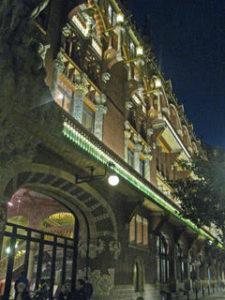
Before an Evening Performance
When walking about in Barcelona, one turns left from a small pedestrianized street just off the Via Laietana. There the traveler is almost immediately confronted by a red brick building that is clearly different from anything surrounding it. This is the Palau de la Música Catalana, and for visitors interested in Barcelona’s architecture, this building is right up there with Antoni Gaudi’s spectacular Sagrada Familia among architectural monuments of Catalan Modernisme architecture, with “Modernisme” used to designate what in other countries is called “Art Nouveau.”
The Palau is such a building and indeed it is not the work of Antoni Gaudi but rather of Lluis Domènech i Montaner. It was built between 1905 and 1908, at the very height of the European Art Nouveau movement, and it is now a UNESCO World Heritage Site (as is the Sagrada Familia). An immediate impression is, quite frankly, that the Palau de la Música Catalana is one of the most remarkable concert halls one is likely to encounter. It was designed to be a concert hall for the people, and the idea of a popular concert hall to provide music for those Barcelonans who could not afford to go to the city’s elegant opera house – the Liceu – originated with a choral group known as the Orfeó Català. Founded in 1891, the Orfeó had quickly earned a reputation for its extraordinary musical quality. Its members and leaders – and its audiences – wanted a suitable venue in which to bring its work to the public. The largest part of the funds needed to build such a hall came from public subscription, and the Palau has long prided itself on bringing music to the people. And, from what one can judge in a performance, there has never been a compromise in the quality of the music presented there. Indeed, the Palau has in its history been led by such stellar names as Richard Strauss, Camille Saint-Saëns, Pablo Casals, and, more recently, Mstislav Rostropovich, Zubin Mehta, and Lorin Maazel.
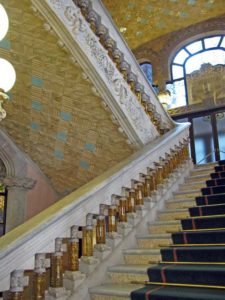
When visiting the Palau, it’s best to slow down when entering through the main entrance vestibule of the building. It’s time to have a special look, especially for the visiting New Yorker. Here, beneath a vault of golden tiles (these with a touch of blue) which amazingly resemble the Guastavino tiles we have in special cherished locations in New York, one is already impressed. Sometimes called Catalan vaulting, the tiling – brought to New York in 1885 by the Valencian architect and builder Rafael Guastavino (1842-1908) – provides the New York visitor a special treat and a bit of homesickness even if the Palau tiles are not from the hand of the master who built them in New York. Under the tiled ceiling to the left and to the right rise the two main staircases. There’s a great sense of openness, originally accented, I suspect, by the fact that the building opened directly onto the street, with no intervening doors. The transition from outside to inside was further enhanced by the presence of two large gilt “streetlamps” at the base of the stairs. The balustrades of the staircases are made up of colored glass cylinders, echoing the gold of the ceiling.
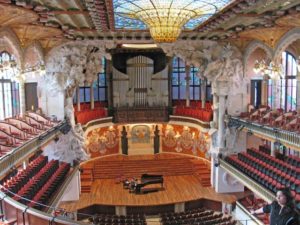
Ascending the stairs takes the visitor into the concert hall, and entering this space is definitely what can only be referred to as a “WOW!” experience! The space of the hall is truly amazing. The outer walls are stained glass, a pale pink with massive floral garlands and other designs. They also form the outer walls of the building itself, which allows light to illuminate the hall from outside. Even more light comes in through the unusual skylight above, with its concentric circles of female faces (members of the chorus, perhaps) and its central section that hangs down into the hall like a massive inverted bell of colored glass, or a huge droplet which may, at any moment, fall.
The proscenium arch is alive with figures, from busts of Beethoven and Catalan poet and composer Anselm Clavé, to a larger-than-life depiction of the ride of the Valkyries. When the Palau was designed, Barcelona was – I was told – “crazy about Wagner” (as, I expect, were the citizens of every other European city at the time). Behind the stage, a frieze depicts eighteen “muses,” each playing a different instrument.
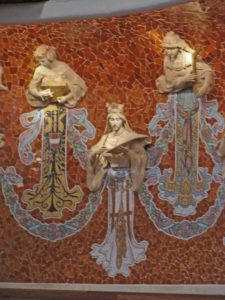
The frieze is unusual in that each figure combines two very different media. From the waist down, each is a mosaic, the figures garbed in colorful and beautifully patterned dresses, each unique. Above the waist, the figures are fully three-dimensional, executed in terracotta and leaning out from the wall. It looks a bit like those old midway booths where you put your head through a hole in a picture and end up looking like a strong man or a movie star, only here eighteen women have stuck their heads and torsos through a mosaic wall. And, yes, perhaps this description is not serious enough, for the end result is very special and certainly adds to the overall WOW of the space.
Rising above the stage is a large organ, its pipes adding to the overall design of the space. When the instrument was renovated in 2000, a computer was installed which allows the organ to be played every day without the benefit of human intervention (other than to turn on the computer program, I suppose). While the idea might seem a bit off-putting to those of us who love organ music but are not organists, organ historians, or organ restoration specialists, the system is actually beneficial to the organ, since – as explained to me – using the pipes on a daily basis prevents dust from building up and damaging them. And when demonstrated, the instrument produces an impressive sound, even without an organist.
Going higher into the Palau, two more flights of stairs lead to the balcony, giving the visitor access to what are described as “the best seats in the house” (and they clearly are). At the same time, another striking difference. These seats put one closer to the remarkable skylight. There are also fine details of the ceiling that aren’t evident from below, including massive fan-shaped supports and still more of the floral decoration found throughout the building.
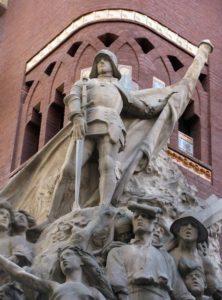
Statue Group Acclaiming the People’s Music
Another distinctive feature of the Palau has to do with its purpose, to serve the common people rather than the wealthy. It lacks the promenading opportunities found in so many of Europe’s opera houses and concert halls. For those places, one went to “be seen,” a ritual that was of equal – or greater– importance to that of the music being performed. Nevertheless, the Palau does boast one space to which one may retire during an interval, a moderately sized room named Lluis Millet Hall, after the Catalan composer and choirmaster of the Orfeó Català. Walls of glass on three sides – with finely wrought Art Nouveau flowers – give the room a light and airy feel. Color is provided not only by the stained glass but by columns completely covered in Modernist mosaics, with flowers again the primary theme. The room is dominated by a massive gasolier (now electric) in what, unusually, might best be described as Arts and Crafts style, rather than Art Nouveau/Modernism.
Leaving the balcony and descending the main staircase, the visitor is once again at the entrance to this captivating and glamorous building. On exiting, the narrow street on which the “front door” of the Palau faces doesn’t allow for much of a vista, but even without the luxury of space, it is clear that the building is as awesome on the outside as it is on the inside. Colorful decorations, a box office (no longer used) carved into one of the large columns, massive busts of musicians, and a statue group at the corner like a ship’s figurehead on steroids: they can all be found on the Palau de la Música Catalana.
Truly a fascinating building and, well, let’s go ahead and say it: perhaps it is “the most beautiful Art Nouveau concert hall in the world.”
Leave a Reply